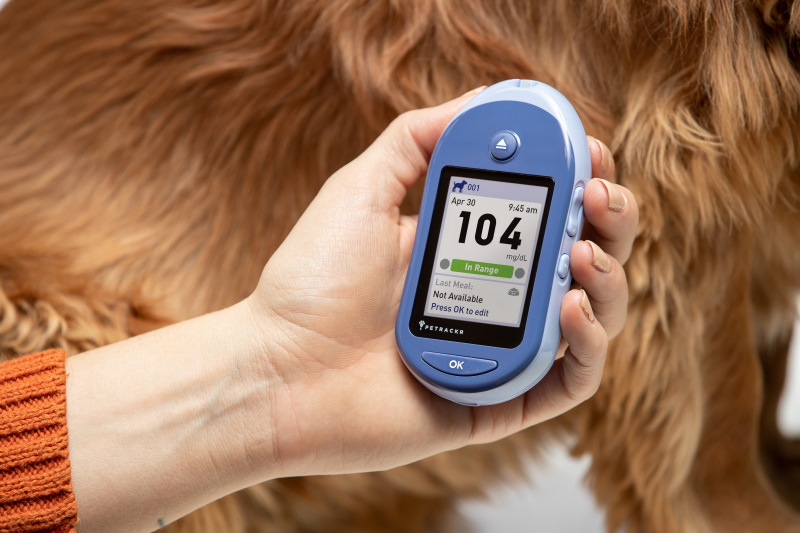Written & Reviewed by an approved Veterinary Medical Writer

Understanding diabetes in dogs is crucial for appreciating the significance of their diet. In diabetes mellitus, the pancreas loses its ability to produce enough insulin or the body’s cells resist it. This leads to high blood sugar levels, which cannot be managed naturally.
Dogs with diabetes usually have Type 1 insulin-dependent diabetes mellitus (IDDM), which means they need twice daily insulin injections. Adjusting their diet helps to prevent high and low blood sugar swings between insulin. Therefore, nutrition plays a vital role in keeping dogs healthy and their blood sugar stable, impacting their overall well-being and quality of life.
What role does nutrition play in helping to manage diabetes in dogs?
Key aspects of nutrition for managing diabetes include:
Balanced nutrients
Diabetic diets are higher in fibre, lower in fat, while providing the right balance of protein and carbohydrate and protein essential for diabetic dogs because it helps maintain stable blood sugar levels, supports their energy needs, and contributes to overall well-being.
Calorie control
Careful portion control and calorie management are crucial for diabetic dogs to prevent weight gain or loss, as these fluctuations can significantly impact blood sugar stability and overall health.
Consistent feeding schedule
Establishing and adhering to a regular and consistent meal schedule is essential for diabetic dogs. This consistency helps synchronise insulin injections with meals, which is key to effectively managing blood sugar levels and preventing dangerous fluctuations. Ask your veterinarian whether you should give insulin before or after your pet’s meal.
Special dietary considerations
Choosing the right type of food, whether it’s commercial diabetic dog food, or a nutritionist-formulated homemade diet, can make a substantial difference in blood sugar management, addressing the unique dietary needs of diabetic dogs and supporting their health.
NOTE: Raw diets are not recommended for diabetic dogs because they are not high enough in fibre and because of the potential for infection in pets who are immune-suppressed.
Monitoring and adjusting
Regularly monitoring your diabetic dog’s response to their diet is a vital part of diabetes management. This proactive approach allows for necessary adjustments to the diet plan, ensuring that blood glucose levels remain stable and within the target range. Let your veterinarian know if your pet is not eating full meals, or if your pet is having any vomiting or diarrhea.

How can I maintain my dog’s nutrition to help them manage diabetes?
Maintaining your dog’s nutrition to help manage their diabetes requires a well-considered approach. Here’s a list of key strategies:
Ensure consistent feeding times
Stick to a regular meal schedule, ideally feeding your diabetic dog at the same time every 12 hours. Encourage strict adherence to feeding times to reduce the risk of low blood sugar.
Provide a tailored diet
Every meal should consist of the same ingredients and calorie content to help stabilise blood sugar levels. Ensure that the meals are tasty and meet half of your dog’s daily calories. Typically, veterinary-prescribed diets are the best option for your dog’s diet, as they contain ingredients specifically formulated to help stabilise blood sugar levels.
Be consistent with treats
Consistency in treating your diabetic dog plays a vital role in their overall well-being. If you offer treats or dental chews, make sure to keep them consistent. This routine helps maintain stability in their dietary habits, ensuring that treats do not disrupt blood sugar management and diabetic control.
Keep an eye out for changes in appetite and drinking
Understand that improved diabetic control may lead to a reduced appetite compared to the excessive hunger and excessive drinking your dog had before treatment.. Monitor your dog’s weight, adjust meal sizes based on their individual requirements, and be patient, as it may take up to 3 weeks to establish a revised feeding routine that suits your dog’s needs. If you notice increased drinking or an increased appetite, these may be early signs that your dog’s diabetes may no longer be under control. Once established, diabetes management will become more straightforward and successful.
By following these strategies, you can effectively maintain your diabetic dog’s nutrition and help them lead a healthier, more stable life.
What kinds of foods should go into the diet of a dog with diabetes?
Carbohydrates
Opt for carbohydrates with a low or medium glycemic index, which cause fewer spikes in blood glucose. Examples include some fruits, vegetables, whole grains, sweet potatoes, and brown rice. Steer clear of highly processed carbohydrates like white bread and white rice, as they can lead to erratic blood glucose levels.
Protein
High-quality protein, such as named meat, is an excellent choice for most diabetic dogs in moderation. It’s digested more slowly than carbohydrates, contributing to stable blood sugar levels. However, dogs with specific health issues like kidney or liver disease may have different protein requirements. Avoid high fat meats such as bacon, mince, pork chops, steak, as they are associated with pancreatitis.
Fat
Fat can provide essential calories for underweight dogs. However, for most diabetic dogs, a low-fat diet is crucial, as up to 30% of them develop diabetes secondary to pancreatitis. This dietary consideration becomes even more critical for overweight diabetic dogs.
Fibre
Incorporating fibre into the diet is beneficial for diabetic dogs as it helps regulate blood sugar levels. While fibre may cause some unwanted gas when the dog first starts the diet, this is temporary. The long-term benefits of preventing blood sugar swings are well worth it.
Not every dog is a candidate for a high fibre diet such as dogs who are very underweight or who have pancreatitis. Dogs who are a normal weight or overweight are often good candidates for high fibre diets. Ask your veterinarian how much fibre is best for your dog.
Treats for diabetic dogs
When it comes to treats, variety is possible even for diabetic dogs. Avoid processed treats high in carbohydrates and propylene glycol. Instead, consider options like freeze-dried meats, dehydrated meats, dried salmon or liver, tuna or sardines in spring water, green beans, sugar snap peas, or carrot sticks. These treats can add flavour and excitement to your dog’s diet without compromising their blood sugar control. Treats should be no more than 10% of their diet each day.

How important is glucose monitoring for ensuring the nutrition of a dog with diabetes?
Glucose monitoring is vitally important for managing your diabetic dog’s nutrition effectively. Here’s why:
Blood sugar regulation
Monitoring your dog’s glucose levels allows you to assess how well their current diet and insulin regimen are working together to regulate blood sugar. This information is crucial for making necessary adjustments.
Individualised care
Every diabetic dog is unique, and their response to diet and insulin can vary. Regular monitoring helps tailor their nutrition plan to their specific needs, ensuring optimal blood sugar control.
Preventing low blood sugar
Monitoring helps prevent hypoglycemia (low blood sugar), which can be life-threatening. You can adjust the timing and composition of meals to maintain stable glucose levels throughout the day.
Evaluating dietary impact
By tracking blood sugar levels before and after meals, you can assess how different foods and treats affect your dog’s glucose. This information guides your choices in selecting the best foods for their diabetes management.
Health monitoring
Consistent glucose monitoring provides insights into your dog’s overall health. Sudden changes in blood sugar levels can signal underlying health issues that may require veterinary attention.
Quality of life
Glucose monitoring gives you warnings if there are any issues with your pet’s diabetes. This will give your pet the best diabetes control possible and will give you peace of mind.
In summary, glucose monitoring is an essential component of managing your diabetic dog’s nutrition. It empowers you to make informed decisions about their diet, insulin dosage, and overall care, ultimately contributing to their health and longevity. Always work closely with your veterinarian to establish an effective monitoring routine and adapt your dog’s nutrition plan as needed.
Where can I get the best quality glucose monitoring for my dog?
PETRACKR’s glucose monitoring system offer a precise and efficient way to track your pet’s blood glucose levels.
PETRACKR’s system streamlines data collection and management for pet health tracking. Their innovative smartphone app enables customisable pet profiles, making it effortless to monitor your dog’s well-being. PETRACKR stands apart from competitors with its unique features:
- Specialised, no-coding test strips simplify the testing process.
- Control testing is not required.
- Seamless switching between measuring blood glucose in cats and dogs without coding or control tests, ideal for multi-pet households.
- Clear test results display with range indicators for low, high, or in-range blood glucose levels, enabling quick assessment.
- User-friendly design with colour display and safe eject button for hygienic disposal of used strips.
- Bluetooth connectivity integrates the analyzer and app, allowing easy recording and tracking of pet’s glucose measurements, insulin doses, meals, and exercise.
- Accurate and straightforward reporting of pet’s results and factors within the app for convenient sharing with veterinarians.
With PETRACKR, managing your pets’ diabetes becomes effortless and reliable. Easily track insulin, meals and exercise along with the blood glucose for complete data tracking and reporting.
Sources
https://www.sydneyvetspecialists.com.au/diabetes-mellitus-in-dogs
https://www.animaldiabetesaustralia.com.au/diabetic-care-of-dogs
https://www.ava.com.au/digest/from-around-the-ava/2021/february/1/nutritional-management-of-diabetic-dogs/ https://www.vet.cornell.edu/departments/riney-canine-health-center/canine-health-information/diets-diabetic-dogs
